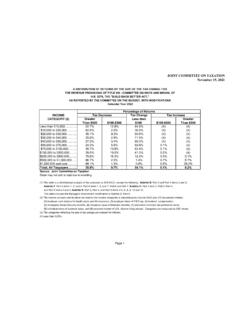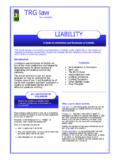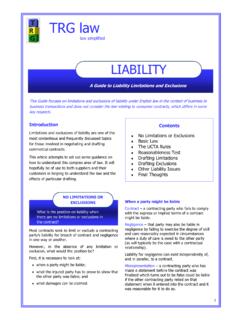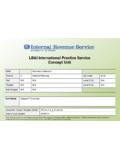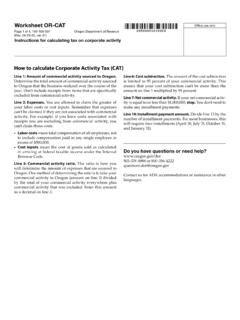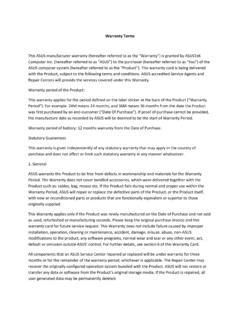Transcription of TAXPAYER CERTAINTY AND DISASTER TAX RELIEF ACT OF …
1 TAXPAYER CERTAINTY AND DISASTER TAX RELIEF ACT OF 2020 Section by Section TITLE I EXTENSION OF CERTAIN PROVISIONS Subtitle A - Certain Provisions Made Permanent Sec. 101. Reduction in medical expense deduction floor. Between 2013 and 2017, individuals under 65 years old could claim an itemized deduction for unreimbursed medical expenses to the extent that such expenses exceeded 10 percent of AGI, while for individuals 65 or older, the threshold was percent of AGI. Prior to this period, the percent threshold generally applied regardless of age. The provision makes permanent the lower threshold of percent for all taxpayers, originally restored for 2017 and 2018 and then extended for 2019 and 2020. Sec. 102. Energy efficient commercial buildings deduction.
2 The provision makes permanent the deduction for energy efficiency improvements to building envelope, lighting, heating, cooling, ventilation, and hot water systems of commercial buildings. The provision updates the ASHRAE Reference Standard from the 2007 standard to the most recent standard as of two years before the start of construction. The most recent Reference Standard is the most recent standard published and affirmed by the Secretary of the Treasury, after consultation with the Secretary of Energy. The provision additionally indexes to inflation the amount of the $ limitation. Sec. 103. Benefits provided to volunteer firefighters and emergency medical responders. The provision makes permanent the exclusions for qualified state or local tax benefits and qualified reimbursement payments provided to members of qualified volunteer emergency response organizations and increases the exclusion for qualified reimbursement payments to $50 for each month during which a volunteer performs services.
3 This provision was originally reinstated for 2020 in the SECURE Act. Sec. 104. Transition from deduction for qualified tuition and related expenses to increased income limitation for lifetime learning credit. The qualified tuition deduction is capped at $4,000 for an individual whose AGI does not exceed $65,000 ($130,000 for joint filers) or $2,000 for an individual whose AGI does not exceed $80,000 ($160,000 for joint filers). After 2020, the provision repeals the qualified tuition deduction and replaces it by increasing the phase-out limits on the Lifetime Learning credit from $58,000 ($116,000 for joint filers) to $80,000 ($160,000 for joint filers). In the vast majority of circumstances, these increased phase-out limits hold harmless those taxpayers who would have otherwise benefited from this deduction.
4 Sec. 105. Railroad track maintenance credit. The provision makes permanent the credit for qualified railroad track maintenance. The credit is equal to 40 percent of expenditures paid or incurred by an eligible TAXPAYER on maintenance of certain railroad track. For expenditures prior to January 1, 2023, the credit is equal to 50 percent of such expenditures. The credit cannot exceed the product of $3,500 times the number of miles of railroad track owned or leased by (or assigned to) the eligible TAXPAYER as of the close of the taxable year. Sec. 106. Certain provisions related to beer, wine, and distilled spirits. The provision makes permanent the reduction of certain excise taxes and simplified record-keeping requirements related to the taxation of beer, wine, and distilled spirits.
5 The provision also modifies certain requirements for in-bond transfers of bottled distilled spirits. Sec. 107. Refunds in lieu of reduced rates for certain alcohol produced outside the United States. The provision provides that, starting in 2023, reduced rates for imports will be administered as refunds by the Treasury Department, rather than determined upon entry by Customs and Border Protection. The refunds shall be paid at least quarterly. The provision also determines how interest will be applied to the amount of the refund. Sec. 108. Reduced rates not allowed for smuggled or illegally produced beer, wine, and spirits. The provision clarifies that reduced rates for beer, wine, and spirits are not allowed for smuggled or illegally produced products. Sec. 109. Minimum processing requirements for reduced distilled spirits rates.
6 The provision modifies the definition of processing for purposes of determining the volume limitations on reduced rates. The provision disregards mere bottling of distilled spirits in determining whose controlled group is relevant for purposes of the limitations . Sec. 110. Modification of single TAXPAYER rules. The provision makes certain modifications to single TAXPAYER rules for beer, wine, and distilled spirits. Subtitle B - Certain Provisions Extended Through 2025 Sec. 111. Look-thru rule for related controlled foreign corporations. The provision extends, through 2025, look-thru treatment for payments of dividends, interest, rents, and royalties between related controlled foreign corporations. Sec. 112. New Markets Tax Credit. The provision extends annual $5 billion allocations of the New Markets Tax Credit for years 2021 through 2025.
7 The provision also extends through 2030 the carryover period for unused New Markets Tax Credits. Sec. 113. Work Opportunity Tax Credit. The provision extends, through 2025, an elective general business credit to employers hiring individuals who are members of one or more of ten targeted groups under the Work Opportunity Tax Credit program. Sec. 114. exclusion from gross income of discharge of qualified principal residence indebtedness. The provision extends, through 2025, the exclusion from gross income for a discharge of qualified principal residence indebtedness. The provision reduces the maximum amount that may be excluded from $2,000,000 to $750,000. Generally, indebtedness must be the result of acquisition, construction, or substantial improvement of primary residence.
8 Sec. 115. 7-year recovery period for motorsports entertainment complexes. The provision extends, through 2025, a 7-year recovery period for motorsports entertainment complexes. A motorsports entertainment complex is defined as a racing track facility that is permanently situated on land and that hosts one or more racing events within 36 months of the month it is placed in service. Sec. 116. Expensing rules for certain productions. The provision extends, through 2025, a deduction for qualified film, television, and theatrical productions of up to $15 million of the aggregate cost ($20 million for certain areas) of a qualifying film, television, or theatrical production in the year the expenditure was incurred. Sec. 117. Oil spill liability trust fund rate. The provision extends, through 2025, the excise tax of $ per barrel on crude oil received at a refinery and petroleum products entered into the United States which is deposited into the Oil Spill liability Trust Fund.
9 Sec. 118. Empowerment zone tax incentives. The provision extends, through 2025, tax benefits for certain businesses and employers operating in empowerment zones. The provision modifies the tax incentives available by terminating the increased expensing on qualifying equipment under section 179 and the deferral of capital gains tax on the sale of certain qualified assets, effective for taxable years beginning after December 31, 2020. Sec. 119. Employer tax credit for paid family and medical leave. The provision extends, through 2025, the employer credit for paid family and medical leave, which permits eligible employers to claim an elective general business credit based on eligible wages paid to qualifying employees with respect to family and medical leave. The credit is equal to percent of eligible wages if the rate of payment is 50 percent of such wages, and is increased by percentage points (but not above 25 percent) for each percentage point that the rate of payment exceeds 50 percent.
10 The maximum amount of family and medical leave that may be taken into account with respect to any qualifying employee is 12 weeks per taxable year. Sec. 120. exclusion for certain employer payments of student loans. The provision extends, through 2025, the allowance for employers to provide a student loan repayment benefit to employees on a tax-free basis. Under the provision, an employer may contribute up to $5,250 annually toward an employee s student loans, and such payment would be excluded from the employee s income. The $5,250 cap applies to both the student loan repayment benefit as well as other educational assistance ( , tuition, fees, books) provided by the employer under current law. The provision applies to any student loan payments made by an employer on behalf of an employee through 2025.







